Table of contents
- What is API Monitoring?
- Why is API Monitoring Important?
- Benefits of API Monitoring
- API Monitoring Use Cases
- Do You Need to Monitor APIs Constantly?
- How to Monitor Your APIs
- API Monitoring as Code
- How to Set Up API Monitoring Using Checkly
- How to Choose an API Monitoring Tool: Key Parameters
- API Monitoring Best Practices
- Conclusion
- Frequently asked questions
What is API Monitoring?
API monitoring is the practice of evaluating how an API (Application Programming Interface) is performing over time via several different metrics, including verifying availability, verifying correctness (i.e., is the data that is being sent and received correctly?), and measuring performance and asserting that against a performance threshold. The goal is to determine whether the APIs are functioning as they should and whether they are available and functioning at an optimal level for the other applications and services that rely on them.
Tracking performance data of APIs, such as response times and variations in performance in the context of different environments, enables you to identify issues with them before customers and other stakeholders do, helping you avoid extended periods of downtime or degraded performance.
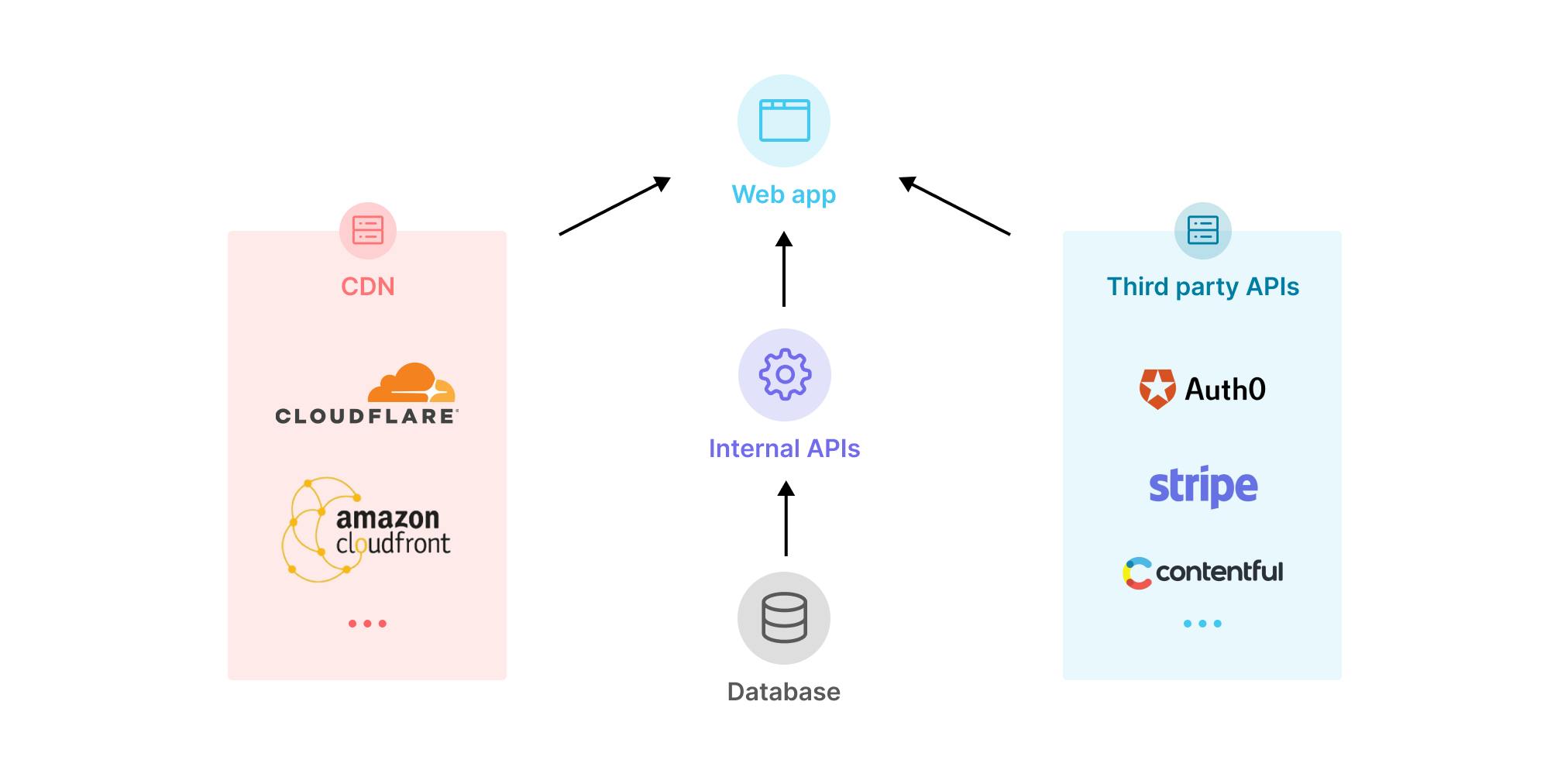
Why is API Monitoring Important?
When a web application or website delivers less than optimal performance—or fails—the impact on your business or customer experience can be significant. API monitoring tools can be used to check your mobile, web app, or other APIs for performance, correctness, and availability.
- Performance Monitoring: Monitoring an API endpoint for response time to requests could involve measuring TCP, DNS, and first byte times.
- Correctness Monitoring: Checking that an API is returning the correct data payload, authentication, status codes, and headers and validating that any given API is functioning correctly.
- Availability Monitoring: Whether your API is available from a single location or via multiple points across the globe, availability is a vital monitoring metric. If an API is accessible on a global basis, monitoring that API from various locations across the globe can give you insight into any region-specific issues.
A good monitoring solution can provide information on all of the aspects outlined above. Once equipped with this knowledge, teams can take the appropriate steps to both fix any damage done as well as improve suboptimal APIs for long-term stability.
More importantly, having an efficient alerting regimen working in concert with your monitoring solution can ensure that the right people are notified of problems as soon as they emerge. Precise and accurate reporting then provides additional insights necessary for a successful investigation into the problem. All of this translates into faster time to recovery, fewer problems being encountered by the end-user, and helps mitigate revenue loss.
Get Started for Free: Try Checkly for API Monitoring Today
Benefits of API Monitoring
API monitoring offers several important benefits that enhance the efficiency, security, and performance of applications and systems. It enables organizations to proactively monitor and detect potential issues, ensuring smooth operations. Here are the key advantages of API monitoring:
| Benefits | Description |
Improved Insights and Performance | Continuous API monitoring provides valuable insights to enhance operations. It identifies bottlenecks, optimizing response times and resource utilization. It also tracks API dependencies, ensuring seamless performance. Moreover, monitoring ensures high availability and detects anomalies for prompt issue resolution. |
Enhanced API Performance | Thanks to API monitoring, you can track performance over time, which then enables you to reduce latency, optimize scalability, detect errors, and optimize caching. |
Improved API Metrics | Monitoring elevates API metrics, including uptime and SLAs. It tracks API uptime, ensuring uninterrupted service, and measures performance against SLAs. By monitoring key metrics like response times and error rates, deviations from agreed standards are promptly addressed. |
API Responses Accuracy | Ensuring the accuracy of API responses is crucial. Monitoring validates data against predefined rules, detects errors, and sets up alert notifications for quick actions. It also provides performance insights related to accuracy. |
Incorporating API monitoring into your software development workflow is instrumental in optimizing operations, enhancing user experiences, and making data-driven decisions for continuous improvements.
API Monitoring Use Cases
Each team will have its own primary use case for API monitoring, but the most common use cases will usually be one of the following.
- Endpoint Uptime Monitoring: The simple monitoring of 'are we returning 200 responses and valid objects?' Regular pinging of API endpoints to ensure they are operational, which is critical for service availability.
- Performance Benchmarking: Tracking the response times of APIs to assess and maintain optimal performance levels. A more analog measurement than uptime monitoring. Seeing that your response times are slipping can indicate underlying infrastructure issues or technical debt in code performance.
- Global Availability Checks: Testing API availability and responsiveness from various global locations to ensure consistent user experiences worldwide. Especially when you have differences in data sovereignty or other cloud architecture differences, this becomes a key check. When I was in Enterprise Services, I always checked our global status first when a high-level customers complained of outages, as geo differences were the most common cause of a hidden issue.
- Versioning and Deployment Validation: Using synthetic monitoring post-deployment to confirm that the API functions as expected, catching issues beyond the scope of unit or integration tests. It's even possible to hook these results directly to a canary deployment system!
- SLA Compliance Monitoring: Measuring API performance and uptime against Service Level Agreements to maintain customer trust and transparency. This SRE's best tool for tracking SLA compliance is an effective API monitoring tool.
Do You Need to Monitor APIs Constantly?
With applications relying heavily on APIs for their functioning, monitoring APIs on a regular, consistent basis becomes a necessary practice in any software development and maintenance project. Companies that are committed to ensuring that end-users have a positive and smooth experience with their product often take advantage of the best API monitoring tools and services to notify them of any issues before customers encounter them.
Around-the-clock, 24/7 API monitoring is essential to catch any issues with APIs that could negatively impact the health of applications. Without API monitoring in place, businesses risk the development of gaps in their knowledge of the application’s status, which can have severe consequences for the stability of the application, and the end-users’ experience of it.
Another compelling reason for 24/7 monitoring is that there are multiple points of potential failure in API operations. An update to the API itself might introduce a bug, which leads to downtime or performance degradation, but the same might happen due to infrastructure reasons (e.g., maybe a server or a hosted cloud instance is overloaded). API monitoring should ideally be incorporated into a team’s larger API testing and monitoring efforts so that they can have a comprehensive view and understanding of the application performance and its various components at any given point in time.
How to Monitor Your APIs
Now that we have established what API monitoring is and why businesses should adopt it as part of their development process, here are some tips to get started.
The first step is to identify which APIs are currently being employed by your system, including both internal APIs as well as external third party APIs. Understanding the exact role they play in the development of your application is crucial to knowing which metrics need to be monitored and tested. Important metrics such as API response time, availability, and data correctness are a few that you will be interested in keeping an eye on.
Requests are sent to the API, whose responses are evaluated in terms of speed, availability, and correctness. In case the response received does not meet the standards laid out for it, the API check registers an error. It is common for monitors to send a second request to that API in the event of a failure. If the API is unreachable or its response is once again inadequate, an alert is triggered, and pre-defined developers and API-providers are informed about the situation.
The next step is to choose an API monitoring tool that will best support your needs. A good monitoring tool will run checks across all your APIs frequently and be able to check for various metrics across criteria such as performance and correctness. With Checkly you can establish a high frequency of checks, which allows you to observe the status of the target system with greater granularity. For example, a critical API endpoint could be monitored every ten seconds to ensure that any issues are caught immediately rather than waiting on a slower monitoring frequency. Additionally, Checkly enables you to monitor APIs from over 20 locations to ensure that they operate smoothly globally.
Checkly’s API monitoring tool is an optimal solution for companies keen to develop and integrate an effective API monitoring flow into their existing development and maintenance processes.
Checkly enables you to streamline the API monitoring process. You can start by creating or importing HTTP requests for the endpoints you want to monitor, then specify assertions against the response (and response time). There are ample opportunities to customize setup and teardown using scripts to fetch OAuth tokens or help clean test data. Checkly has data centers in twenty locations worldwide, from which it can run API checks up to every ten seconds. This is crucial to get a comprehensive and accurate picture of the health of your APIs. Finally, depending on your workflow, Checkly also integrates with services such as Slack, email, and Pagerduty to notify and alert you of any incidents.
API Monitoring as Code
You can also use Checkly with Infrastructure-as-Code tools like Terraform and Pulumi, or the official Checkly CLI, to extend the benefits of IaC to collaborative API monitoring, having your monitoring defined right next to your existing code and fitting your existing workflows.
- Get Started for Free: Try Checkly for API Monitoring Today
How to Set Up API Monitoring Using Checkly
Setting up API monitoring using Checkly is straightforward, with all its sufficient resources, features and guides. If you’re able to build a working API, then you should find it easy to follow the steps below and start monitoring your APIs.
Let’s see how to set up API monitoring using Checkly:
Step 1: Sign up for a Checkly Account
To get started, head over to the Checkly website and sign up for an account if you don’t have one already.
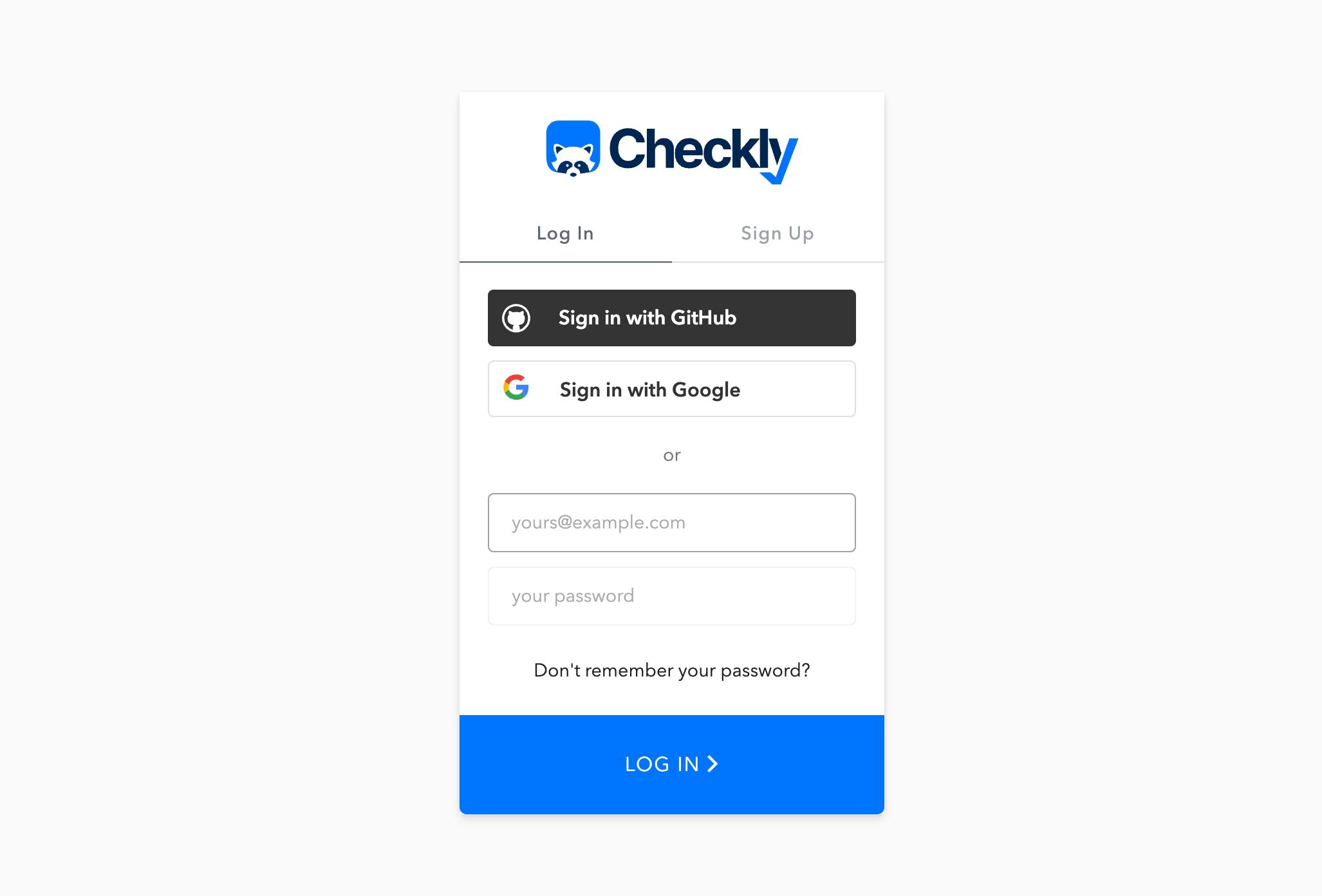
By default, you have access to a free Team trial which expires after 14 days, so in order to continue enjoying the advanced features, you can subscribe to a pricing plan depending on your needs and requirements.
Step 2: Create a New Check
Once you've signed up and logged in, you can proceed to a Browser Check, API Check or use the CLI script.
Let’s play around with the API Check. On your dashboard, click the "API Check" tab (you can toggle between tabs). You should see an interface like this:
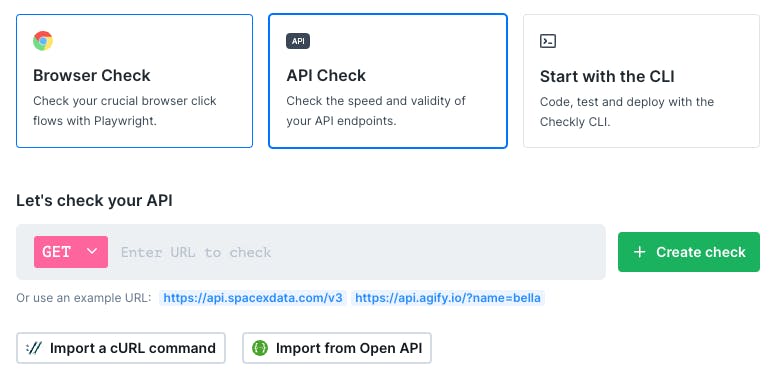
You can either check your API, by entering the URL and selecting the HTTP method (GET, POST, PUT, DELETE) the URL accepts, import using a cURL command or import from Swagger or OpenAPI.
For instance, using cURL, make a request to your API in your browser, go to the developer tools and find the particular request you want to monitor. Let’s use a request from https://fakestoreapi.com, and copy the request from the Chrome developer tools as cURL just like the image below:
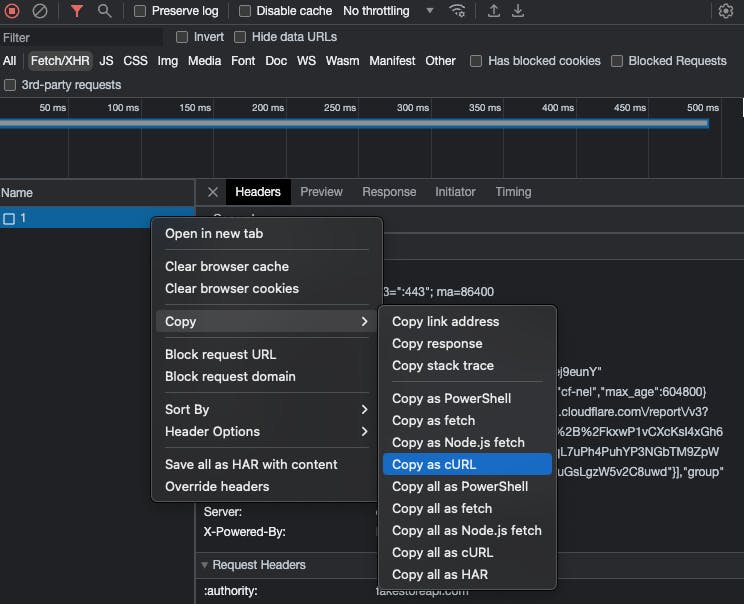
Here is what the cURL looks like:
curl 'https://fakestoreapi.com/products/1' \
-H 'authority: fakestoreapi.com' \
-H 'accept: */*' \
-H 'accept-language: en-US,en;q=0.9' \
-H 'dnt: 1' \
-H 'if-none-match: W/"16c-MMdrqY6N0sTiefLdsgtBej9eunY"' \
-H 'referer: https://fakestoreapi.com/' \
-H 'sec-fetch-dest: empty' \
-H 'sec-fetch-mode: cors' \
-H 'sec-fetch-site: same-origin' \
-H 'user-agent: Mozilla/5.0 (iPhone; CPU iPhone OS 13_2_3 like Mac OS X) AppleWebKit/605.1.15 (KHTML, like Gecko) Version/13.0.3 Mobile/15E148 Safari/604.1' \
--compressedGo back to your Checkly dashboard and click the “Import a cURL command” button. A dialog box will pop up. Paste the cURL you copied in the input field and then click “Import cURL”.
Now, you should have a more detailed interface containing information and settings for the API request.
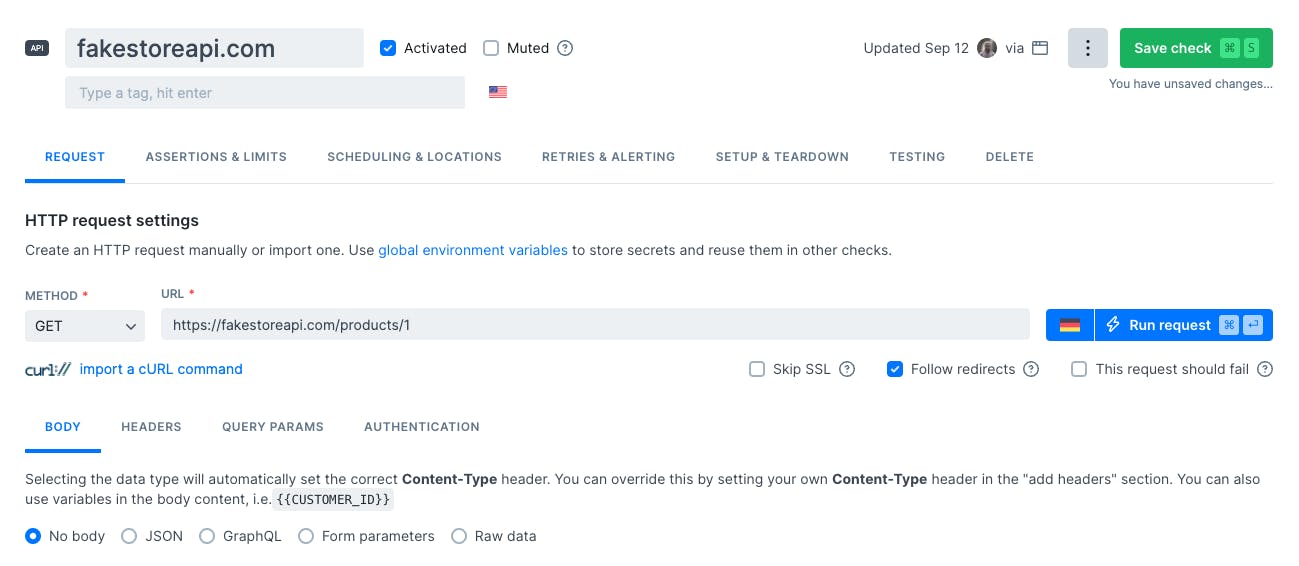
Step 3: Configure the Request Settings
In this step, you need to configure various settings for your check. Start by giving your check a name that describes its purpose or functionality. You can also add optional tags to categorize your checks.
Next, since the cURL command already specified the request details such as the HTTP method (GET, POST, PUT, DELETE), URL, headers, body/query parameters and authorization (tokens or API keys), the Checkly UI enables you to change/update these details.
Step 4: Set Up Monitoring Frequency
Monitoring frequency determines how often Checkly will send requests to your API endpoint to check its availability and performance across multiple or selected data centers under the “SCHEDULING & LOCATIONS” tab.
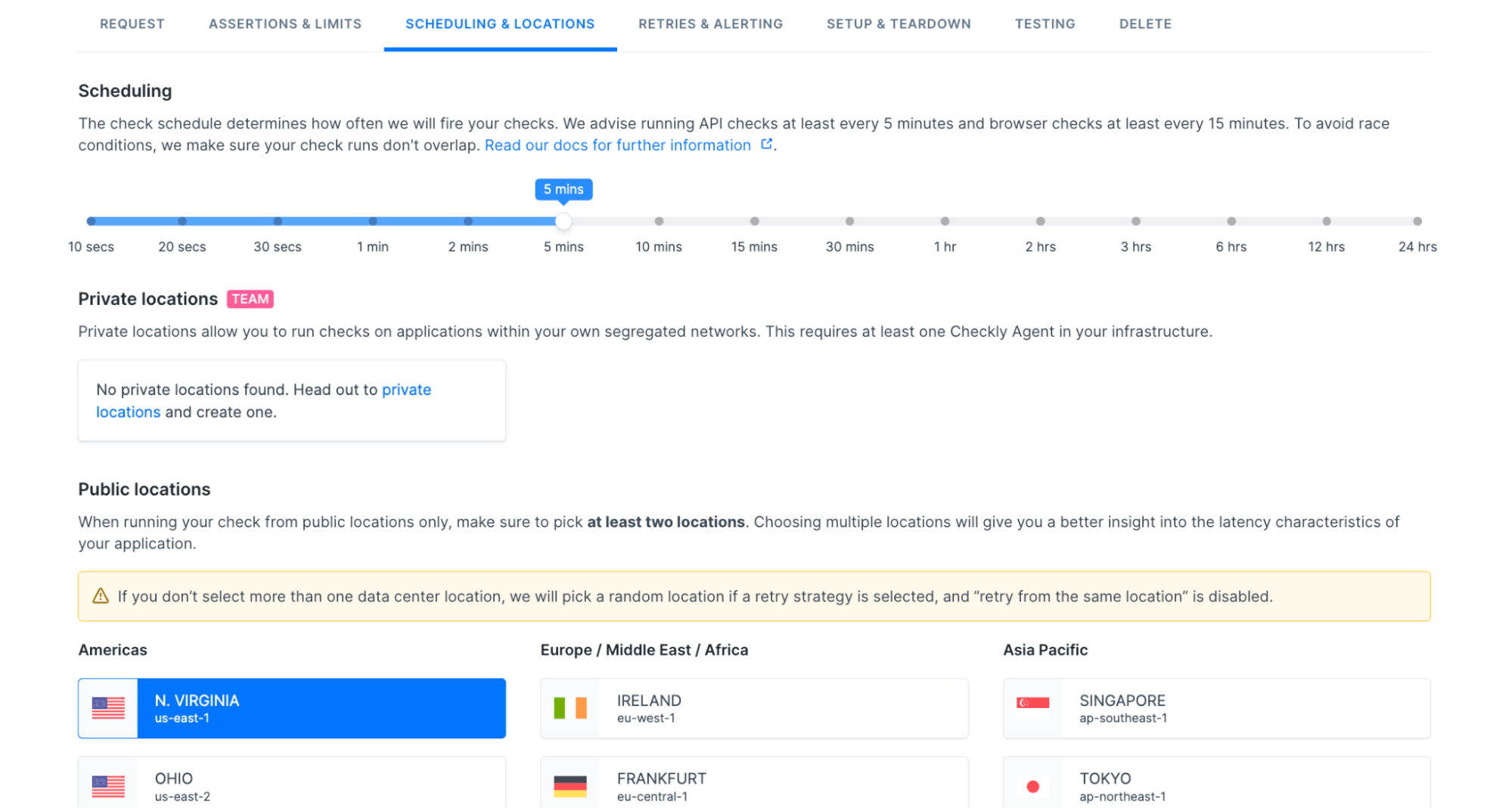
You can choose from various intervals like every minute or custom intervals based on your needs. You can also add assertions and limits to validate specific response criteria like status codes or response time.
Step 5: Define Alert Channels
Alert channels allow you to receive notifications when issues or errors are detected during API monitoring. Checkly supports multiple alert channels including email, phone calls, SMS, Slack, Discord, Telegram, PagerDuty, Webhooks and more. Configure the desired alert channels and provide relevant contact information.
Step 6: Review and Save
Before saving your check configuration, it's essential to review all the settings and ensure they accurately meet your needs and requirements. Double-check the request details, assertions, monitoring frequency, and alert channels. Once you're satisfied, click the green “Save Check” button at the right-top corner.
Step 7: Monitor and Analyze
With your API check set up, Checkly will start monitoring your APIs according to the defined frequency. You can now sit back and let Checkly do its job.
Checkly provides comprehensive dashboards and reports to help you analyze the performance and health of your APIs. Utilize these insights to identify potential bottlenecks, optimize response times, and ensure overall reliability.
From our example in this article, Checkly is monitoring the API from our Fake Store API.

By following these steps and utilizing Checkly's intuitive interface and features, you can easily set up a comprehensive API monitoring strategy. Implementing a reliable monitoring solution like Checkly helps you stay proactive in identifying and resolving issues before they impact your users or business.
How to Choose an API Monitoring Tool: Key Parameters
When choosing the best API monitoring tools, it's essential to consider several key parameters to select the right one among the many available options. These parameters will help you choose a tool that meets your specific requirements and ensures the effective monitoring of your APIs. Let's explore these parameters in detail.
API monitoring usability
Usability is paramount when selecting API monitoring tools. Opt for a tool with an intuitive interface, customizable reports, and streamlined setup. Real-time alerts can be a game-changer, providing instant notifications through various channels like email, Slack, or SMS to keep you informed and allow prompt action.
Additionally, look out for monitoring tools betting on code-first configuration with a Monitoring as Code approach to control and update your monitoring setup and application in the same process.
Valuable API monitoring metrics
Metrics are essential for evaluating API performance. Here are some key metrics to consider when monitoring APIs:
- Response Time: This metric measures the time it takes for API transactions to take place. By monitoring the response time, you can identify if there are any delays or performance issues.
- Error Rate: The error rate metric helps you determine the percentage of requests that encounter errors. Monitoring this metric enables you to proactively identify and resolve any issues that may impact the reliability of your APIs.
- Throughput: Throughput measures the number of requests processed by an API within a given time frame. Monitoring throughput can help you determine if your API can handle the expected load and scale appropriately.
- Latency: Latency is the delay between sending a request and receiving a response. By monitoring latency, you can identify any delays in data transmission and optimize your API's performance.
Tools like Checkly offer real-time data collection and visualization, enabling data-driven decisions for improving API performance monitoring.
Essential monitoring integrations
Integration ensures seamless operations and efficient error detection. Choose a tool with robust integration capabilities, like Checkly, which integrates with tools like Slack, PagerDuty, and Jira. It also offers a REST API for automation and integration into existing workflows.
Resources and technical support
Support is vital for a smooth monitoring experience. API monitoring tools provide support in various ways, which include:
- Documentation: Look for tools that offer well-written and detailed documentation. This should include clear instructions on how to set up and configure the tool, as well as troubleshooting guides for common issues.
- Community: A strong and active community can be a valuable resource for users. Look for tools that have a vibrant community where users can ask questions, share experiences, and learn from each other.
- Customer support: It's essential to have access to responsive customer support in case you encounter any issues or need assistance. Look for tools that offer multiple channels of communication, such as email or live chat, and have reasonable response times.
- Training and resources: Some API monitoring tools provide additional training resources, such as webinars or tutorials, to help users understand the tool's features and capabilities better.
By considering these parameters, you can confidently select an API monitoring tool that meets your specific requirements, enhances security, optimizes performance, integrates seamlessly, and provides reliable support throughout your monitoring journey.
API Monitoring Best Practices
Having a comprehensive API monitoring strategy is crucial for ensuring the smooth functioning of your APIs and identifying any issues before they cause major problems.
To get the best from your API monitoring strategy, consider the following practices:
| Best Practice | Description |
Set Clear Objectives | Clearly define your monitoring goals. Determine what aspects of your APIs you want to monitor, such as response times, error rates, or throughput. This will help you set up effective monitoring and focus on what matters most to your business. |
Establish Baseline Metrics | Before deploying your APIs, establish baseline metrics to understand their normal behavior. This will enable you to quickly identify any anomalies or deviations from the expected performance. |
Monitor Key Performance Indicators (KPIs) | Identify and monitor the key performance indicators that directly impact the user experience or business outcomes. This may include response time, error rates, latency, and availability. Tracking these KPIs will help you stay proactive in addressing potential issues. |
Implement Real-Time Alerts | Configure real-time alerts to promptly notify you when an API metric exceeds a predefined threshold or encounters an error. This allows for immediate action and minimizes downtime. |
Leverage Synthetic Monitoring | In addition to monitoring production APIs, consider implementing synthetic monitoring by simulating user interactions with your APIs. This enables you to proactively test and monitor critical functionalities without impacting real users. |
Analyze Historical Data | Analyzing historical monitoring data can provide valuable insights into trends, patterns, and potential areas for optimization. Use this data to make informed decisions and continuously improve your API performance. |
By following these best practices, you can optimize your API monitoring strategy, minimize downtime, enhance performance, and ensure a seamless user experience.
Conclusion
In summary, API monitoring is essential for ensuring the security, performance, and reliability of APIs. It enables organizations to proactively detect and address issues, prevent security breaches, optimize performance, and deliver accurate data to users. By implementing effective monitoring practices and choosing the right tools, organizations can maintain the smooth functioning of their APIs.
If you're considering implementing API monitoring in your projects, try Checkly for free. Explore our comprehensive monitoring solutions to enhance your API performance and ensure a seamless experience for your users.
Learn more about API monitoring and how it helps you to avoid production issues.

